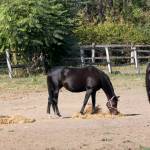Botulism in Horses: Seasonal Considerations

It’s that time of year again. Fall, football, and fear of botulism invade our thoughts as pastures go dormant and we start rolling out hay bales. We hear tales of botulism, the dangerous effects of Clostridium botulinum toxins (there are seven types: A, B, C1, D, E, F, and G), and are warned to avoid possible contaminants at all costs. We are advised to vaccinate against botulism, although only Type B vaccinations are licensed for use in horses. Botulism intoxication (usually not an infection) occurs rapidly and quickly becomes lethal.
Why is the botulinum toxin so devastating, and how exactly does it work? To answer that question, it helps to know the potential stages in the development of toxicity: delivery of the toxicant from the site of exposure to its target; reaction of the toxicant with its target; cellular dysfunction and the resulting toxicities; and inappropriate repair and adaptation.
Stage One: Delivery of the toxicant from the site of exposure to its target. Horses have two susceptible exposure sites: the gastrointestinal tract and wounds. The gastrointestinal tract can be exposed to botulinum toxin by ingesting the toxin directly, or by ingesting bacteria that colonize and begin producing the toxin. The toxin is absorbed into the bloodstream from the gastrointestinal tract. Wounds, especially deep puncture wounds or those with necrotic tissue, support the growth of C. botulinum bacteria. As the bacteria produce the toxin, it is absorbed into the bloodstream from the wound. Once in the bloodstream the toxin circulates in search of its target molecule. Botulinum toxins have remarkable specificity, and their target molecule is a protein found in the peripheral terminals of motorneuron endplates. Motorneurons are part of the central nervous system (CNS), and their axons extend outside the CNS in order to control muscle function.
Stage Two: Reaction of the toxicant with its target. When a toxicant reaches its target molecule, it may bind to or alter that molecule. Botulinum toxin acts enzymatically on a specific target protein by acting as a zinc-protease. The toxin prevents the release of acetylcholine at motorneuron endplates, thus affecting the transmission of impulses between endplates and nerves. Another known toxin having a zinc-protease lethal factor is anthrax, which causes cell death by inactivating mitogen-activated protein kinase kinase (MAPKK).
Stage Three: Cellular dysfunction and the resulting toxicities. Botulinum toxin causes cellular dysfunction by binding to the presynaptic membrane of cholinergic terminals and blocking the transmission of acetylcholine. Occurring at the endplate between the neuron and muscle cell, it manifests as muscle weakness that rapidly progresses to paralysis.
Stage Four: Inappropriate repair and adaptation. No repair mechanism exists for extraction of the botulinum toxin after it has reached and reacted with its target molecule. The bond between the toxin and the protein receptor is irreversible. If the influx of the toxin can be stopped or mitigated by the administration of antitoxin, the horse can begin synthesizing new neuromuscular junctions. The antitoxin can only bind to free, unbound botulinum toxin and not to toxin already affecting nerves. Unfortunately, the seven to ten days required for new growth is often more time than the horse has before paralysis of the diaphragm (the last muscle affected by the toxin) and respiratory paralysis occurs.
Understanding how the botulinum toxin works illustrates how imperative quick action is when faced with possible intoxication. It also underscores just how effective and deadly this toxin can be. Even with vaccination and careful management, horses can be affected by this devastating disease.








